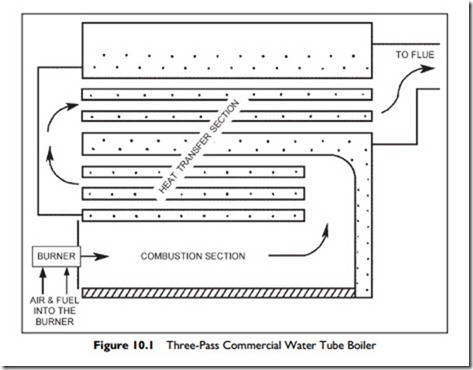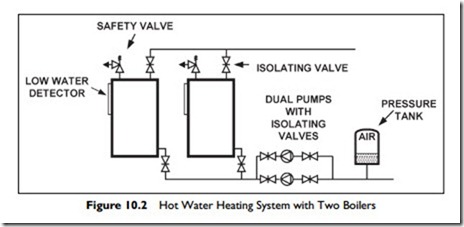Boilers
Boilers are pressure vessels used to produce steam or hot water. They are different from furnaces, a term usually used to refer to air heaters of any size. Boilers come in a vast range of types and sizes.
The critical design factor is pressure. Boilers are fitted with safety valves that release the steam or water if the pressure rises significantly above the design pressure. The safety-equipment requirement and staff-monitoring requirements are far less stringent for low-pressure boilers, so there is a significant incentive to use low-pressure except where high pressure is needed, or more economic.
A “low-pressure” steam boiler operates at a pressure of no more than 15 pounds per square inch, 15 psig, more than the local atmospheric pressure. This means 15 psig as measured by a gauge exposed to the local atmospheric pressure. In comparison, “low-pressure” hot water boilers are allowed up to 160 psig. There is a good reason for the extreme difference in allowable pressure:
When a steam boiler fails, the effect can be catastrophic: as the steam expands uncontrollably, it is like a bomb going off. In comparison, when a hot water system bursts, the hot water pours out, but there is no explosive blast like there is with steam. For this reason, “low-pressure” hot water boilers are allowed up to the higher pressure of 160 psig.
Boilers and system components are regulated by codes. These codes are generally written, and updated, by practitioners in their geographic area. The main codes in North America are those issued by the American Society of Mechanical Engineers (ASME) Boiler and Pressure Vessel Code while the European Community has their own, and in many areas, much less demanding set of codes. It is there- fore critical that a designer or operator knows the local code requirements, since their experience from one place may not be relevant in another jurisdiction.
Boiler Components
Boilers have two sections, the combustion section and the heat transfer section.
The combustion section is the space in which the fuel-air mixture burns.
Figure 10.1 shows a commercial boiler with the combustion chamber at the bottom. In this boiler, the base is insulated, but the top and sides of the combustion chamber are heat transfer surfaces. The proportion of air significantly influences the efficiency. If there is excess air, it is heated as it goes through the boiler, carrying heat with it up the chimney. Too little air will cause poor combustion, usually producing noxious combustions products and, in the extreme, may cause extra expense by allowing unburnt fuel through the boiler and up the chimney.
The second section of the boiler is the heat-transfer section. This section comprises the two upper spaces in Figure 10.1, where the hot gases pass right to-left and then left-to-right, before exiting to go up the flue. In large boilers, the heat transfer section will be fabricated of cast iron sections that are bolted together, or of welded steel plate and tubes. In smaller, particularly domestic, boilers, the heat-transfer section may be fabricated from copper, aluminum or stainless steel sheet. Boilers can be designed for any fuel: electricity, gas, oil, or
coal are the most usual. In this age of recycling and sustainability, there is also an initiative to use urban and manufacturing waste as fuel.
In all boilers, there is a need to modulate, or adjust, the heat input. Gas and oil burners may be cycled “on” and “off.” The longer the “on” cycle, the greater the heat input. With the “on-off” cycle, the water temperature or steam output will vary up and down, particularly at low loads. This may not matter, but the efficiency improves and cycling effect is much reduced by having a burner with “high-low-off” cycles.
On larger units, a modulating burner will usually be installed that can adjust the output from 100% down to some minimum output. The burner modulation range is called the “turn-down ratio,” which is the ratio between full “on” and the lowest continuous operation. A burner that can operate at anywhere from 100% output down to 10% output has a 10:1 turn-down ratio. With a modulating burner, efficiency increases as the output drops. This increase in efficiency is due to the increase in the ratio of heat-exchanger surface-area to heat-input as the output, or firing rate, is reduced.
In a coal-fired boiler, the adjustment is achieved by altering the draft of combustion air through the grate. As the air supply increases, the fuel burns faster and hotter, increasing the boiler output.
In general, boiler efficiency drops as the mean temperature of the heated fluid rises. As a result, a hot-water boiler will be more efficient heating water from 150°F to 170°F (mean temperature 160°F) than from 160°F to 180°F (mean temperature 170°F). However, the cooler the mean temperature of the heated fluid, the larger the heat-transfer surfaces must be. Here we have another example of where the designer must consider trading the higher ongoing costs and use of fuel against initial equipment costs.
Because boiler operation is critical for the facility, it is often valuable to have a two boiler system, so that there is always one available for maintenance back up.
Figure 10.2 shows a hot water system with two boilers.
The boilers, which are connected in parallel so that one can be valved off and serviced or replaced while the other continues to operate.
Two pumps, so that pump failure does not prevent operation.
A pressure tank which maintains system pressure and accommodates the changes in water volume as the system is heated up from cold. The
pressure tank often has a membrane in it that separates the water from the air, to prevent absorption of oxygen from the air. If the water level drops too low, more water is pumped into the system; if the pressure needs to be increased, more air is pumped into the top of the tank.
A spring-loaded safety valve, which is provided for each boiler. The valve is set to release at some pre-determined pressure. Then if, for example, the burner controls jammed at full fire, the hot water or steam would be released, protecting the system from bursting.
A low water detector/cutout, which is fitted for each boiler. This safety device prevents the boiler from operating with little, or no, water and overheating, which could easily cause serious damage to the unit.
Dissolved oxygen and other chemicals in normal domestic water can cause severe corrosion and fouling of the heating system, especially with steel pipework. In closed hot water systems, water treatment chemicals may be added as the system is filled. Then, periodically, the system water quality is checked and any needed additional treatment added.
In steam systems, the makeup water must be treated to remove oxygen and dissolved solids before it enters the boiler. This is to prevent the boiler from filling with dissolved solids, since steam (pure water) is continuously boiled off. The steam is very corrosive, so a chemical treatment is included to offset the corrosive characteristics. Thus, there is a need for frequent monitoring, since any failure of treatment can cause problems in the boiler and distribution systems.
With the two boilers in parallel, about half the water will flow through each boiler. If just one boiler is firing, the supply temperature will be based on the average temperature of the return water from the idle boiler and the heated water from the firing boiler. If the supply-temperature requirement equals the temperature that is produced by the operating boiler, then the flow through the idle boiler must be stopped, by closing the inlet valve. For systems with low summer loads, this is ideal since the efficiency is maintained and the idle boiler can be serviced with no interruption of hot-water production.
Note that with steam boilers, if one is running, both will fill with steam to the same pressure. The operating boiler keeps the second boiler hot and ready to fire.
Having considered the heating plant, now let us turn our attention to cooling and consider chillers and cooling towers that, together, provide central chilled water in many buildings.

